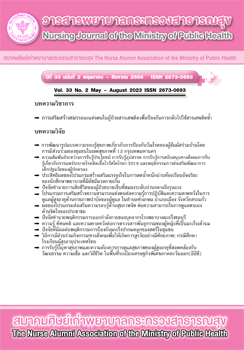Trajectories of Engagement in Social Activities for Active Aging: A Case Study of Older Adult Schools in Thailand
Main Article Content
Abstract
This qualitative study aimed at explaining the nature and mode of continuous engagement in social activities that lead to active aging among older adults regarding four dimensions, including engagement in activities, mode of engagement, management of problems and barriers, and results of the engagement in social activities. The sample was selected through multi-stage sampling from six regions of Thailand. One school was selected from each region, and 60 key informants were purposively selected from older adults who engaged in school-based activities for more than three years. Data were collected by conducting in-depth interviews using semi-structured interview forms developed by the researchers. The data obtained were analyzed to create an inductive conclusion. The findings revealed that the way of continuous engagement in social activities leading to active aging in older adults consists of a decision to participate in activities for the following five reasons: 1) received information about the activity; 2) self-management; 3) the form of social activity; 4) known acquaintances in activities; and 5) the benefits of activities, and engagement in activities, which was divided into four phases: 1) starting from activities in which older adults had experience, knowledge, ability, and which were suitable for older adults’ health; 2) performing activities according to one's abilities; 3) self-assessment and resulting benefits; and 4) proposing methods to modify activities to ensure continuity of participation in activities. The findings indicated that activities that older adults can engage in on an ongoing basis to support active aging must be compatible with their leisure time and allow them to manage their engagement. In addition, older adults should receive support in order to participate in the activities, and be able to identify activities that are consistent with community context, beneficial, and suitable for older adults.
Article Details

This work is licensed under a Creative Commons Attribution-NonCommercial-NoDerivatives 4.0 International License.
บทความและรายงานวิจัยในวารสารพยาบาลกระทรวงสาธารณสุข เป็นความคิดเห็นของ ผู้เขียน มิใช่ของคณะผู้จัดทำ และมิใช่ความรับผิดชอบของสมาคมศิษย์เก่าพยาบาลกระทรวงสาธารณสุข ซึ่งสามารถนำไปอ้างอิงได้
References
Chayomchai A, Petmee P, Treemek W, Sarnthong J, Autum J, Ngao-ngam R. Recreation in the elderly Thai people: supporting, motivation, satisfaction, and benefit view of recreational activities. IJSR 2020;6(3):177–93.(in Thai)
Danpradit P, Kittichottipanich B, Sribhen R. Problems and needs in basic elderly care of health volunteers in Nakorn Pathom Province. VNJ 2019;21(2):23–33.(in Thai)
Rupavichet P, Rupavichet P. Strategic of education management for the elderly forwards developing active ageing. CMU J. Edu. 2018;2(3):17-30.(in Thai)
Amnauy S. Model of health promotion behaviors for the elderly in Janlan Sub-district, Kuchinarai District Kalasin Province. JESEH 2023;8(1):576-81.(in Thai)
Vichean U, Sornjaeng D, Boonrasri J. Development of the health care new normal model for elderly Chachoengsao Province. JR TAN. 2021;22(3):151-9.(in Thai)
Aunkamol P. Social participation, self-esteem and life satisfaction of the elderly at Jatuchak District in Bangkok Metropolitan. Journal of Social Sciences Srinakharinwirot University. 2019;22(1):125-36. (in Thai)
Narushima M, Liu J, Diestelkamp N. Lifelong learning in active ageing discourse: its conserving effect on wellbeing, health and vulnerability. Ageing & Society 2018;38(4):651-75.
Wongprom J, Jongwutiwes K, Prasertsuk N, Jongwutiwes N. Community participation in the development of older persons’ quality of life. Veridian E-Journal, Silapakorn University 2015;8(3):41-54. (in Thai)
Vudhironarit S, Yuhan-ngoh N, Sarai K. The developing a participation-building model for promoting active ageing among older adults. IRR 2023;18(1):23-30.
Homsombat P, Tabaselo PS, Fangkham B, Sornsakda S. Elderly school: enhancing potentials of elderly in aging society. IJERI 2022;6(2):540-51.(in Thai)
Worawong C, Sridawruang C, Thawinkarn D, Manasatchakun P. The development of aged friendly community: Tambon Naphu aging school, Amphur Phen, Udonthani . NJPH 2020;30(2):150-63. (in Thai)149
Office of the National Economic and Social Development Council. A goals and guidelines for regional development 2023–2028. Bangkok: The National Economic and Social Development; 2022. (in Thai)
Larson J, Johnson A, Aiken-Wisniewski SA, Barkemeyer J. What is academic advising? An application of analytic induction. NACADA Journal 2018;38(2):81-93.
Connelly LM. Trustworthiness in qualitative research. Medsurg Nursing. 2016;25(6):435-36.
Wongsala M, Anbäcken EM, Rosendahl S. Active ageing–perspectives on health, participation, and security among older adults in northeastern Thailand–a qualitative study. BMC geriatrics 2021; 21:1-10.
Aroogh MD, Shahboulaghi FM. Social participation of older adults: a concept analysis. IJCBNM 2020;8(1):55-72.
Levasseur M, Généreux M, Bruneau JF, Vanasse A, Chabot E, Beaulac C, et al. Importance of proximity to resources, social support, transportation and neighborhood security for mobility and social participation in older adults: results from a scoping study. BMC Public Health 2015; 15:503.
Lai DW, Qin N. Extraversion personality, perceived health and activity participation among community-dwelling aging adults in Hong Kong. PloS one 2018;13(12):e0209154.
Ohnuma T, Hashidate H, Yoshimatsu T, Abe T. Clinical usefulness of indoor life-space assessment in community-dwelling older adults certified as needing support or care. Nihon Ronen Igakkai Zasshi 2014; 51:151-160.
Aroogh MD, Shahboulaghi FM. Social participation of older adults: a concept analysis. IJCBNM. 2020;8(1):55-72.
Levasseur M, Routhier S, Clapperton I, Doré C, Gallagher F. Social participation needs of older adults living in a rural regional county municipality: toward reducing situations of isolation and vulnerability. BMC geriatrics 2020; 20:1-12.

